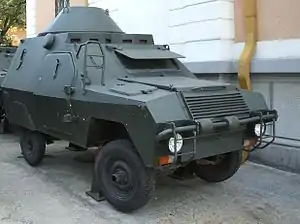ABI (Military land vehicle)
Autovehicul Blindat pentru Intervenție (ABI, "Armored Vehicle for Intervention") was a Romanian armored car based on the chassis of the ARO 240 off-road vehicle. Intended for escort and counterinsurgency missions, the ABI armored vehicle was manufactured by Automecanica Moreni. The export variant was known as AM 100 ALG.
| ABI | |
|---|---|
 ABI in the National Military Museum, Romania | |
| Type | Armoured Car |
| Place of origin | Romania |
| Service history | |
| Used by | Romania Algeria Liberia |
| Production history | |
| Designer | Direcția Tancuri și Auto |
| Designed | 1978—1979 |
| Manufacturer | Automecanica Moreni |
| Produced | 1979 |
| No. built | 17[1] |
| Variants | AM 100 ALG[2] |
| Specifications | |
| Mass | 4,000 kilograms (4.4 short tons; 3.9 long tons) |
| Length | 4.22 m (13 ft 10 in) |
| Width | 2.225 m (7 ft 3.6 in) |
| Height | 1.65 m (5 ft 5 in) (hull) |
| Crew | 2 + 4 passengers |
| Armor | 4–10 mm |
Main armament | 12.7mm DShK machine gun |
Secondary armament | 7.62 PK machine gun |
| Engine | Model D-127 4-stroke diesel 68 hp |
| Power/weight | 17 hp/tonne |
| Transmission | 4 × 4 |
| Ground clearance | 0.195 m (7.7 in) |
Operational range | 600 km (370 mi) |
| Maximum speed | 90 km/h (56 mph) |
| References | [2] |
History
Development
In June 1978, the Romanian government expressed their desire to have an armored car based on the ARO 240 vehicle that was equipped with a machine gun.[3] It was to be supplied to airport security units. A prototype was completed by the end of the year. On May 27, 1979, Nicolae Ceausescu ordered the manufacture of a batch of armored vehicles to parade at the August 23 military parade.[4] The armored car, known as the ABI, was also presented to the Romanian Army, but it was rejected and solely used for airport security.[5] 17 ABIs made their appearances in the military parade on August 23, 1979.
Service
ABI vehicles were used during the Romanian Revolution of 1989 , when they were involved in several notable incidents, such as the massacre by USLA troops in front of the Ministry of Defense headquarters.[6][7][8][9][10]
Design and specifications
ABI was built on the chassis used by the ARO 240. The armor was made of welded steel plates, 4-10 mm thick, and provided protection only against small caliber bullets and splinters.[2] The armored vehicle was vulnerable to 7.62 mm perforated cartridges.
The driver was seated on the left at the front of the vehicle, and the commander was on the right. The commander had two firing ports at his disposal. One firing port was to the right of the windscreen and the other was a window in front of him. The driver had only one window to fire inside the vehicle.[2] The windshield and left door window were bulletproof. The windows could be additionally protected with folding armor plates, without visible slots. If the windows were covered, the commander and the driver used the six periscopes to see outside. The rear soldiers had four firing ports at their disposal to shoot: two in the rear doors and one in the sides. To see the outside, the soldiers used two observation slots and two periscopes. The turret was equipped with a 7.62 mm PK machine gun.
Variants
Operators
References
- Urdăreanu 2004, p. 539.
- Foss, Christopher (2002). "ABI armoured car". Jane's Armour and Artillery, 2002-2003. Jane's Information Group. ISBN 0-7106-2425-5. OCLC 50194997.
- Urdăreanu 2004, p. 14.
- Urdăreanu 2004, p. 117.
- Urdăreanu 2004, p. 556.
- Mincan, Mihai (December 2, 2009). "Seful USLA catre Militaru: Mi-ati omorat oamenii!" [USLA chief to the Military: You killed my people!]. Adevărul (in Romanian). Archived from the original on February 26, 2021. Retrieved August 16, 2021.
- Mincan, Mihai (November 29, 2009). "Crimele Revolutiei: macelul de la MApN" [The crimes of the Revolution: the massacre at the Ministry of National Defense]. Adevărul (in Romanian). Archived from the original on February 26, 2021. Retrieved August 16, 2021.
- Mincan, Mihai (December 1, 2009). "VIDEO Generalul Militaru, spionul ucigas" [VIDEO General Military, the killer spy]. Adevărul (in Romanian). Archived from the original on February 26, 2021. Retrieved August 16, 2021.
- Mincan, Mihai (November 30, 2009). "Macelul de la MApN: crime si profanare" [The massacre at the Ministry of National Defense: crimes and desecration]. Adevărul (in Romanian). Archived from the original on March 6, 2021. Retrieved August 16, 2021.
- Botez, Cristian (December 22, 2010). "Rănile deschise ale Revoluției" [The open wounds of the Revolution]. Ziarul Timpul (in Romanian). Archived from the original on February 28, 2021. Retrieved August 16, 2021.
- Urdăreanu 2004, p. 542.